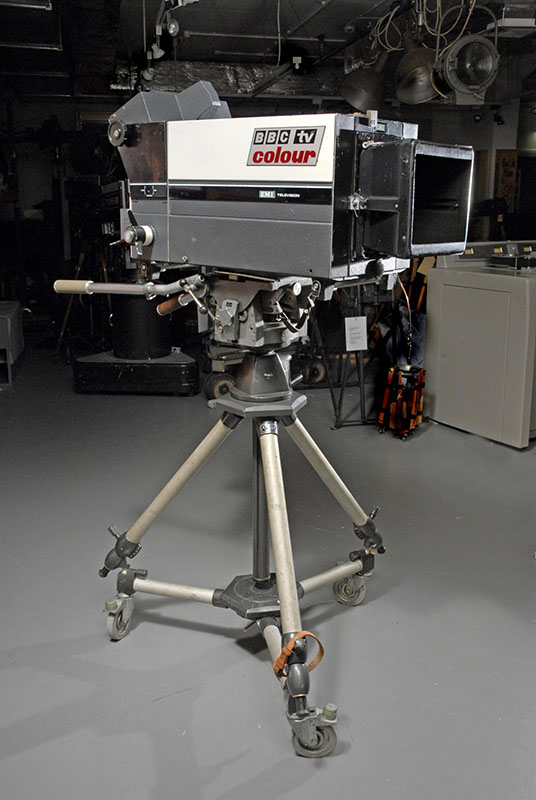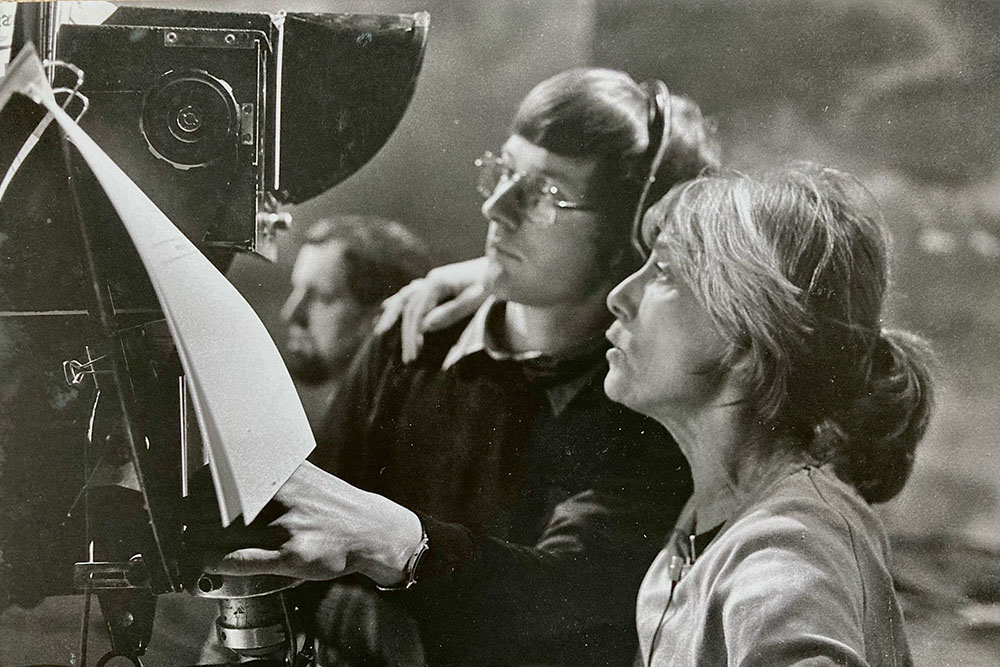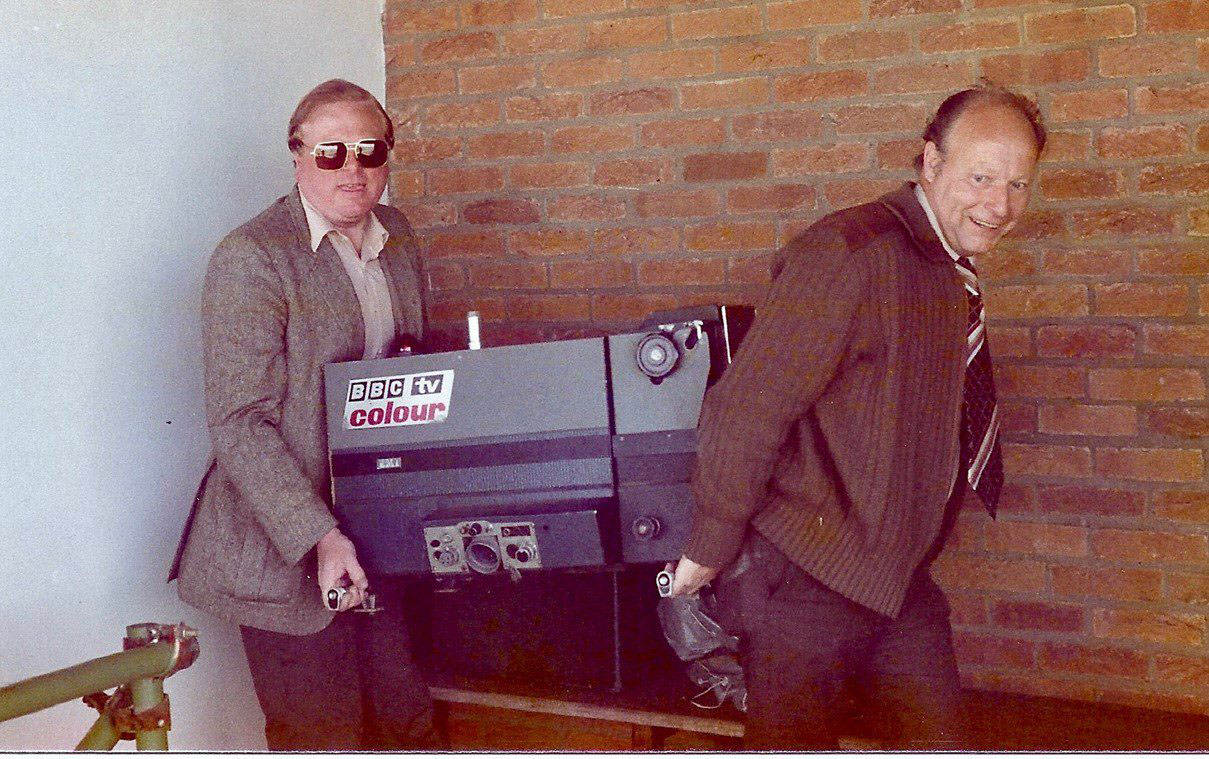This year we are working in partnership with the BBC to develop an exhibition celebrating the last 100 years of broadcasting. As part of this we have been collecting memories from the BBC alumni group to gain a better understanding of the working practice of objects held in our television collection.
The iconic EMI 2001 television camera received the most nostalgic responses—read on to discover how they worked, what they were used for and why they were so well-loved.
Simon Curtis, Broadcast Cameraman and Camera Supervisor, 1987–present:
“I joined the BBC in 1987 having had the ambition to be a BBC cameraman since the age of eight—at school I might as well have said I wanted to be an astronaut! The EMI 2001 was certainly iconic with the BBC logo on the side and I’d dreamt of operating them, but alas by the time I arrived at Television Centre as a new camera trainee they’d already been replaced by Link 110s and 125s.
“Fortunately, soon after with shifts allocated at BBC Elstree I found, to my delight, that the 2001s were still being used on EastEnders. I’d finally achieved my dream and I do so wish a photo existed of that time with me and the camera with the classic ‘BBC TV Colour’ signs on the side! How they all fitted in the sets back then and with cables virtually the size of a man’s forearm, is almost beyond me!”

David Short, Broadcast Cameraman, 1981–present:
“The EMI 2001 was the first television camera I operated. Ask any TV cameraman of a certain vintage, and the EMI 2001 comes out as a favourite camera to operate.
“It was such a classic design it even featured on a Royal Mail stamp which, I believe, was given to all staff at the time.
“Before the days of hand-held cameras, I recall doing a shot on Angels, a hospital drama, with four of us ‘hand-holding’ an EMI 2001 camera to simulate a patient’s point of view on a hospital trolley.
“They were, of course, tube cameras (pre CCD) and the technology couldn’t always handle highlights in the shot. If you watch some of the old Top of the Pops shows you may notice some of the lights in shot tend to smudge and smear. This was known as ‘comet tails’. Also, when makeup and costume would come onto the set to take their continuity Polaroids, they would warn us before taking the picture with a flash, by saying ‘flashing’ to give us time to pan off the cameras to avoid damage to the tubes.
“One thing that only cameramen would know was the little ‘message’ system we had with the EMI 2001. The zoom-demand handle has a screw-thread end stopper on it. During idle moments on long programme days you would unscrew the end to see if someone had left a little ‘note’ in the hollow. If not, then you could add something for a cameraman in the future to read. Inevitably, the notes would range from the banal to the inspired. I wish I had kept some of them!
“The EMI 2001 was retired from TV Centre in the late 1980s but some were moved up to Elstree studio C where, in 1991, EastEnders became the last programme in the world to use EMI 2001 cameras.”

Robin Sutherland, Broadcast Cameraman, Camera Supervisor and OB Craft Leader, 1966–2016:
“My first memory of using EMI 2001s was when I was a junior cameraman at Television Centre in 1968. They rapidly replaced the first colour camera in service, the unloved Marconi Mk 7, an extremely big and unwieldy camera with a long lens sticking out of the front. The 2001 was a revelation to operate. Compact and well-balanced, almost half the length with the zoom lens buried in the body, it was an instant hit with cameramen, enabling them to achieve complex development shots with ease without assistance. Everyone loved it!
“I transferred to London Outside Broadcasts in 1969 and again saw the 2001 come into service in the second generation of OB Mobile Control Rooms. They gave great service on all the main units and specialist vehicles such as the Roving Eye, mounted on the roof of a Citroën estate car. The cameraman sat exposed on the roof with a driver and engineer inside and it towed its own power generator. The signal was transmitted back to a receiving point in the grandstand. [It was] used on the Grand National, Royal Ascot and many other race meetings.

“OB cameras have a much harder life, being constantly rigged and derigged for each programme and then transported in a truck to the next location. Despite all this they were very reliable and gave wonderful service for well over a decade.

“The design of the 2001 meant all the main components were placed at the rear of the camera. When the lens was removed to reduce weight for rigging, it meant the camera was twice as heavy at the rear end. One particular cameraman, Bob Buttimere, always seemed to choose the lighter front end when it had to be carried around and it entered OB folklore, universally known as ‘the Buttimere end’.

“36 years later I was reacquainted with the camera on the ADAPT project where we made a 1970s-style programme using vintage equipment.”

The ADAPT project (2013–18) researched the history of British broadcast television technology between 1960 and the present day. Find out more at the ADAPT project website.

In 2022 we are celebrating the last century of TV, radio and streaming with Broadcast 100, a bumper year of exhibitions and events across the Science Museum Group. Visit us this summer to see more objects from the BBC Heritage Collection on display.
As engineers we referred to them as “watercolour cameras” as they had four tubes, the main sharpness coming from a mono tube selected for it’s sharpness and the colours painted in with 3 colour tubes. Lining them up was an art form, and you could really see the fruits of your labours on screen.
I enjoyed reading the comments from other cameramen and how they loved their cameras. Thank you for sharing your love of a craft that seems to be disappearing due to technology of microprocessors.
A coloured card cut-out model of an EMI 2001 on a Vinten Hydraulic Pedestal is available from Bernie Newnham – profits to charity – via the BBC Tech Ops website – an example is shown on this page: http://tech-ops.co.uk/next/colour-supplement/
Please contact Bernie via email.
The site includes a large number of references to the EMI 2001 and stories associated with its use.
Also available FREE is a coloured card cut-out model (1/12scale) of a Vinten Heron – a camera crane often paired with EMI 2001 on Top of the Pops: URL is
http://tech-ops.co.uk/next/vinten-heron-cutout-card-model-1-12-scale/
Fantastic to see this page of information about this iconic camera , The EMI 2001 was the camera that got me interested in broadcast TV and cameras .
I used to look out for cross dissolves and red tally lights on TOTP, trying to figure out which camera was taking each shot .
The camera was so iconic for many reasons, from its relatively compact design ( lens encased within the camera body, to the four tube system ) love it!!
I thought i was the only one on the planet that did that, also i used time the cuts with the music by clicking my fingers. :)
This is a late reply ! But I did the same, was never clever enough to be a cameraman :-( but loved the production side ov tv, lucky enough to attend a few 70s TOTPs, and watched the crew more than the acts ! Can confirm, if you get clonked on the head by a passing camera ..it hurts ! Lol
Also went to many sit com recordings, again watched how it was done, and how camera crew rearranged shots to avoid shadows from the Mike boom etc
I always thought they used Thompson cameras, wasn’t aware of the EMI model, very interesting read, I wanted to do that when I was a child so when I was older bought my own video camera, nearest thing to real thing.
… there are many things in the history of television broadcasting that could be considered “iconic” … the EMI 2001, however, is not one of them … the beeb bought quite a few because they had a hand in its design and were required to “buy British” but, other than that, hardly anyone else anywhere else in the rest of the world bought them … so maybe the word you could properly use to describe them would be “beebish” …
Brilliant post! I always remember seeing the titles of Swap Shop as a child and seeing one of thosd cameras! Hearing the memories of operating them is a delight thanks!
I joined the BBC in 1979 as a women cameraperson. In the interview process I was asked to undertake a spinal X-ray to check that I would be able to lift the camera equipment!
This is a very interesting article as long, long, long time ago I had a dream of being a cameraman but unfortunately due to my disability in those days it precluded you from getting in. I am still interested in all that goes on in the TV & Film industry (more behind the scenes) so if there is every an exhibition it would Great to view. Thank you for the article.
I joined the BBC in 1969 we had 3 months training at BBC Wood Norton there was only one 2001 there and we were told it was for “engineers” only and us cameramen on pain of death must not play with it! So it wasn`t till I arrived at Television Centre that I got to use it.
It was a joy to use ergonomically it was so good and I have so many memories of using it you put the panning handle vertical and it became a part of you, also watching other senior staff create magical moments, be it Ron Green on Stuart Morris variety shows or Jim Atkinson and Dave Mutton on dramas. On youtube there is the opening sequence of the Mikado, one long shot by Jim .
Something I do remember and I wonder if you have one in your collection was a left over from turret camera days,a strip of paper which had lens angles marked on it so you could programme the “shot box” on the 2001 a very useful tool on fast sit-coms and music shows to hit the mark.
How about getting some stories about the other “tools of the trade” peds and cranes -Moles Herons and Nike`s
Hi Steve,
Plenty of stories on the BBC Tech Ops website:
http://www.tech-ops.co.uk/next/
CeeJay is correct.
If this camera was so good, how come virtually zero were sold abroad?
Only the UK ran this camera as it was so big, heavy, no real choice of lenses, old-fashioned, expensive to run and expensive to buy. Cameramen may have liked it, but it just didn’t sell, hence it was effectively the end of EMI Ltd. in cameras. From these perspectives, it was a failure. A commercial disaster area . . .
From an ecomonic point of view, prior to 1973 there were strict trade barriers on the importation of broadcast television equipment into the UK which is why all cameras to that date were from British manufacturers – Pye, Marconi and EMI – and which probably explains the domestic popularity of the 2001, being the best of a small pool of available equipment. After joining the EEC the barriers were watered down to allow purchases from fellow EEC members which then saw the rise introduction of Thomson, Phillips and Bosch hardware. In 1980 these final barriers were axed which resulted in the rapid dominance of Japanese broadcast equipment and the withdrawal of British manufacturers, hit by expensive development costs, a poor history of exports and the security of what was effectively a captive UK market.
Of course other nations did not have these barriers in place, or to that extent, and so could purchase from a bigger market. In that context the 2001, with its’ integral lens which restricted the number of lens suppliers, did not appeal when compared with cameras with front-mounted lenses that allowed a far greater choice of lens providers.
I joined the BBC in 1969, and there was a mix of b&w and colour cameras. I learnt to go to stores and get specialist lenses for the turret, and how to change them using a crank handle or motorised turret.
But I also learnt on the 2001, which was a masterpiece of engineering. Its compact size and good balance meant it was easy to control and pivoted how you wanted it – and it was easy to avoid camera shake. Focus was so smooth, although I often had difficulty with getting a smooth start on a zoom.
The really easy to use shot-box helped the transition from turrets, and the pan handle was really comfortable and customisable (although I never got on with the idea of putting it business end vertical). A 4-man lift, it’s true (and what about those who managed to fail to locate the mounting wedge properly and a push on the ped had the camera on the floor!)
They were definitely iconic, in that they were what most people recognised as a BBC TV camera.
Unlike turret cameras and those with stick-out zooms, 2001s really felt a part of you when you used them. Above all, with the 4 tubes, the picture quality was always superb as the luminance signal didn’t depend on the alignment of the colour tubes.
…”the Buttermere end” 😂😂😂
I’ve been away from London for nearly 35 years…is Bob still with us?
I never worked on the 2001 professionally, but have two of them here in the collection at the TV camera museum. They were much liked at the time by cameramen and also the electronic maintenance staff. The circuitry was straight forward using simple components and easy to repair.
A choice of six lenses were available form two different manufactures. When looking back you must view them as a product of their time. True the camera was heavy but then so were the other cameras of the time.
It was not just the BBC that liked them, LWT ordered 22 of them in 1968.
Readers may like to have a look at the EMI 2001 pages at :- http://www.tvcameramuseum.org/emi/2001/2001index.html
Brian, It didn’t sell anywhere except the UK, and even then, no more than 200 units which was not enough to fund the next generation of product. Some were on demo in the USA and France, but to my knowledge, none were sold. By the time it finally appeared, it was way late in being a completed design, too old in concept (4 tube), cost a lost of money, made with consumer grade components, expensive to run and so, so heavy. It was eventually manufactured way past its ‘sell by’ date in relatively low volume.
Compare with the contemporary Marconi MkVIII from 1970 onwards. Almost three times the sales, a wide (genuine) choice of lenses, less than half the weight, 3 tubes and so much more. The BBC bought 2 (news), then went on to commission the Link 110 – in effect, a very budget 3 tube 2001.
The EMI 2001 was an outdated commercial failure, despite all the plaudits from cameramen. As a consequence, it was effectively the end of EMI in broadcast TV cameras – you can’t count the EMI 2005 (incredibly low sales), or the ‘badge engineered’ EMI 2008 (a CEI camera).
We have multiple examples of EMI 2001s at our new museum at: http://www.becg.tv
Interesting material about the EMI cameras, happy days. As I own a film and photo archive it’s most apt.
Whitehaven Film and Photographic Archive.
Am I right in saying that lenses used were the French lens, Angenieux 10x35E zoom lens or was this attached to an earlier camera?
I appreciate hearing recollections from those at the BBC who worked with and like the EMI 2001. In 1976 when I was 11 – this is the television camera my father recreated for me (life-size – in wood and hardboard!).
Hi all. I actually own an EMI2001 camera complete with the huge separate power and control boxes plus the massive cable which connects them to the camera itself. It has the CRT viewfinder, Pangenieux lens and I’ve even got the period headphones too. It does power up but no picture because it’s been sat since the early 90’s in a warm dry room but obviously not used. I bought it primarily to use as a prop in my own studio and it’s never failed to grab peoples attention. It’s on a tripod so it looks great. I am looking to find it a new home and would hugely appreciate any advice on it’s value etc. More than happy to field any discussions so please feel free to reach out to me.
These marvellous cameras were as much a part of British television’s heyday as the programmes shot using them. They always fascinated me, as did broadcasting in general.
I wonder what they cost when new. Anyone know?